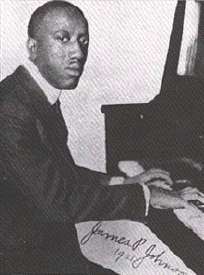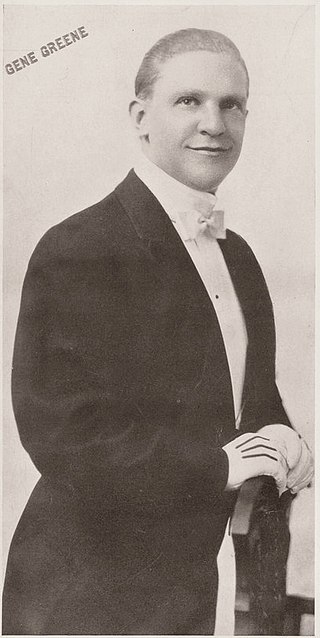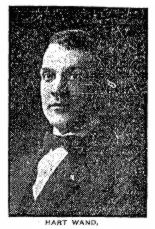
Blues is a music genre and musical form that originated amongst African-Americans in the Deep South of the United States around the 1860s. Blues incorporated spirituals, work songs, field hollers, shouts, chants, and rhymed simple narrative ballads from the African-American culture. The blues form is ubiquitous in jazz, rhythm and blues, and rock and roll, and is characterized by the call-and-response pattern, the blues scale, and specific chord progressions, of which the twelve-bar blues is the most common. Blue notes, usually thirds, fifths or sevenths flattened in pitch, are also an essential part of the sound. Blues shuffles or walking bass reinforce the trance-like rhythm and form a repetitive effect known as the groove.

Ragtime, also spelled rag-time or rag time, is a musical style that had its peak from the 1890s to 1910s. Its cardinal trait is its syncopated or "ragged" rhythm. Ragtime was popularized during the early 20th century by composers such as Scott Joplin, James Scott and Joseph Lamb. Ragtime pieces are typically composed for and performed on piano, though the genre has been adapted for a variety of instruments and styles.

William Christopher Handy was an American composer and musician who referred to himself as the Father of the Blues. He was one of the most influential songwriters in the United States. One of many musicians who played the distinctively American blues music, Handy did not create the blues genre but was the one of the first to publish music in the blues form, thereby taking the blues from a regional music style with a limited audience to a new level of popularity.
This is a list of notable events in music that took place in the year 1912.

A honky-tonk is both a bar that provides country music for the entertainment of its patrons and the style of music played in such establishments. It can also refer to the type of piano used to play such music. Bars of this kind are common in the South and Southwest United States. Many eminent country music artists, such as Jimmie Rodgers, Ernest Tubb, Lefty Frizzell, Hank Williams, Loretta Lynn, Patsy Cline, Johnny Horton, and Merle Haggard, began their careers as amateur musicians in honky-tonks.

James Price Johnson was an American pianist and composer. A pioneer of stride piano, he was one of the most important pianists in the early era of recording, and like Jelly Roll Morton, one of the key figures in the evolution of ragtime into what was eventually called jazz. Johnson was a major influence on Count Basie, Duke Ellington, Art Tatum, Thelonious Monk, and Fats Waller, who was his student.

"The Saint Louis Blues" is a popular American song composed by W. C. Handy in the blues style and published in September 1914. It was one of the first blues songs to succeed as a pop song and remains a fundamental part of jazz musicians' repertoire. Benny Goodman, Louis Armstrong, Cab Calloway, Bing Crosby, Bessie Smith, Eartha Kitt, Count Basie, Glenn Miller, Guy Lombardo, Peanuts Hucko, Art Tatum, and the Boston Pops Orchestra are among the artists who have recorded it. The song has been called "the jazzman's Hamlet". Composer William Grant Still arranged a version of the song in 1916 while working with Handy.

Eugene Delbert Greene was an American vaudeville and ragtime singer. He was one of the first to use scat singing techniques.
Little is known about the exact origin of the music now known as the blues. No specific year can be cited as its origin, largely because the style evolved over a long period but blues is inarguably a Black American art form as it is noted "it is impossible to say exactly how old blues is - certainly no older than the presence of Negroes in the United States. It is native American Music, the product of the Black in this Country or to put it more exactly the way I have come to think about it, blues could not exist if African Captives had not become American Captives". Ethnomusicologist Gerhard Kubik traces the roots of many of the elements that were to develop into the blues back to the African continent, the "cradle of the blues". One important early mention of something closely resembling the blues comes from 1901, when an archaeologist in Mississippi described the songs of black workers which had lyrical themes and technical elements in common with the blues.

Hart Ancker Wand, was an American early fiddler and bandleader from Oklahoma City, Oklahoma. He was of German extraction. In the musical world he is chiefly noted for publishing the "Dallas Blues" in March 1912. "Dallas Blues" was an early example of published twelve-bar blues song.

"The Memphis Blues" is a song described by its composer, W. C. Handy, as a "southern rag". It was self-published by Handy in September 1912 and has been recorded by many artists over the years.
This is a timeline of music in the United States from 1880 to 1919.

"Nigger Blues", written by Le Roy "Lasses" White, was one of the first blues songs published. Copyrighted by the Texas-born White in 1912, it was first titled "Negro Blues", but for unknown reasons when White published it in 1913, he retitled it.

Hugo Cannon was an American songwriter and pianist whose best-known composition was the popular ragtime song "(Won't You Come Home) Bill Bailey".

"Margie", also known as "My Little Margie", is a 1920 popular song composed in collaboration by vaudeville performer and pianist Con Conrad and ragtime pianist J. Russel Robinson, a member of the Original Dixieland Jazz Band. Lyrics were written by Benny Davis, a vaudeville performer and songwriter. The song was introduced by the Original Dixieland Jazz Band in 1920 as Victor 78, 18717-A, in a medley paired with "Singin' the Blues". The B side was "Palesteena". The ODJB recorded their instrumental version on December 1, 1920.

"Livery Stable Blues" is a jazz composition copyrighted by Ray Lopez and Alcide Nunez in 1917. It was recorded by the Original Dixieland Jass Band on February 26, 1917, and, with the A side "Dixieland Jass Band One-Step" or "Dixie Jass Band One-Step", became widely acknowledged as the first jazz recording commercially released. It was recorded by the Victor Talking Machine Company in New York City at its studio at 46 West 38th Street on the 12th floor – the top floor.

The period from the end of the First World War until the start of the Depression in 1929 is known as the "Jazz Age". Jazz had become popular music in America, although older generations considered the music immoral and threatening to cultural values. Dances such as the Charleston and the Black Bottom were very popular during the period, and jazz bands typically consisted of seven to twelve musicians. Important orchestras in New York were led by Fletcher Henderson, Paul Whiteman and Duke Ellington. Many New Orleans jazzmen had moved to Chicago during the late 1910s in search of employment; among others, the New Orleans Rhythm Kings, King Oliver's Creole Jazz Band and Jelly Roll Morton recorded in the city. However, Chicago's importance as a center of jazz music started to diminish toward the end of the 1920s in favor of New York.

H. Franklin "Baby" Seals was an American vaudeville performer, songwriter and pianist, whose successful 1912 song "Baby Seals' Blues" was one of the first published blues compositions, predating W. C. Handy's "The Memphis Blues" by several months.
Hitchy-Koo is a 1912 American popular song and a series of musical revues, inspired by the song, staged on Broadway each year from 1917 through 1920 and on tour in 1922.















